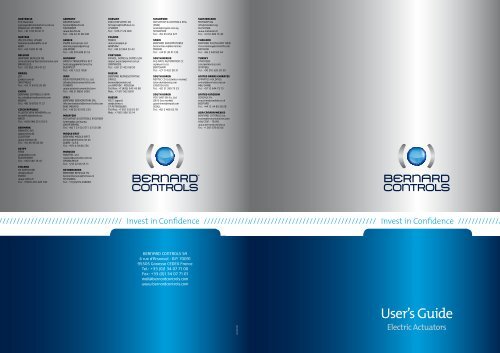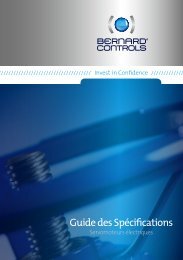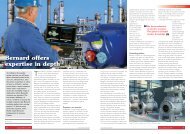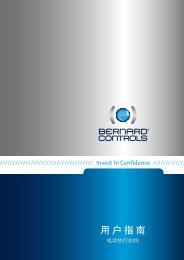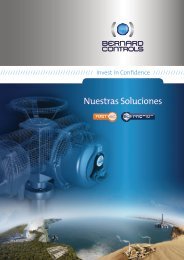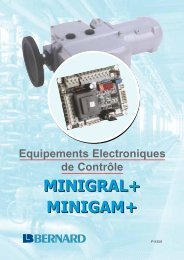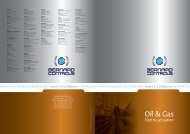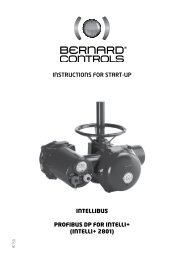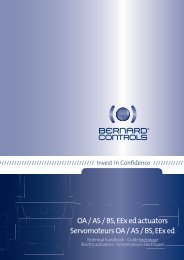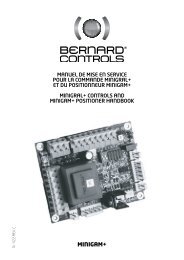User's Guide - Bernard Controls
User's Guide - Bernard Controls
User's Guide - Bernard Controls
You also want an ePaper? Increase the reach of your titles
YUMPU automatically turns print PDFs into web optimized ePapers that Google loves.
AUSTRALIA<br />
FCX Australia<br />
p.proeger@transmark-fcx.com.au<br />
ROWVILLE, VICTORIA<br />
Tel. : + 61 3 97 65 61 11<br />
AUSTRIA<br />
IPU ING PAUL UNGER<br />
hammermueller@IPU.co.at<br />
WIEN<br />
Tel. : +43 1 602 41 49<br />
BELGIUM<br />
BERNARD BENELUX SA<br />
arnaud.baert@ bernard-benelux.com<br />
BRUXELLES<br />
Tel. : +32 (0)2 343 41 22<br />
BRAZIL<br />
JCN<br />
jcn@jcn.com.br<br />
SAO PAULO<br />
Tel. : +55 11 39 02 26 00<br />
CHINA<br />
BERNARD CONTROLS CHINA<br />
bcc.info@bernardcontrols.com<br />
BEIJING<br />
Tel. : +86 10 8739 77 27<br />
CZECH REPUBLIC<br />
FLUIDTECHNIK BOHEMIA s.r.o.<br />
brno@fluidbohemia.cz<br />
BRNO<br />
Tel. : +420 548 213 233-5<br />
DENMARK<br />
ARMATEC A/S<br />
jo@armatec.dk<br />
GLOSTRUP<br />
www.armatec.dk<br />
Tel. : +45 46 96 00 00<br />
EGYPT<br />
ATEB<br />
gm@atebco.com<br />
ALEXANDRIA<br />
Tel. : +203 582 76 47<br />
FINLAND<br />
OY SOFFCO AB<br />
info@soffco.fi<br />
ESPOO<br />
www.soffco.fi<br />
Tel. : +358 0 207 420 740<br />
GERMANY<br />
DEUFRA GmbH<br />
bernard@deufra.de<br />
TROISDORF<br />
www.deufra.de<br />
Tel. : +49 22 41 98 340<br />
GREECE<br />
PI&MS Entreprises Ltd<br />
ioannis.pappas@pims.gr<br />
HALANDRI<br />
Tel. : +30 210 608 61 52<br />
HUNGARY<br />
APAGYI TRADEIMPEX KFT<br />
bela.apagyi@mail.tvnet.hu<br />
BUDAPEST<br />
Tel. : +36 1 223 1958<br />
IRAN<br />
ASIA INSTRUMENTS Co. Ltd.<br />
info@asiainstrumentsltd.com<br />
TEHRAN<br />
www.asiainstrumentsltd.com<br />
Tel. : +98 21 8850 3065<br />
ITALY<br />
BERNARD SERVOMOTORI SRL<br />
info.servomotori@bernard-italia.com<br />
RHO /MILANO<br />
Tel. : +39 02 931 85 233<br />
MALAYSIA<br />
ACTUATION & CONTROLS ENGINEER<br />
tcmeng@pc.jaring.my<br />
JOHOR BAHRU<br />
Tel. : +60 7 23 50 277 / 23 50 281<br />
MIDDLE-EAST<br />
BERNARD MIDDLE-EAST<br />
bernact@emirates.net.ae<br />
DUBAI - U.A.E.<br />
Tel. : +971 4 39 80 726<br />
MOROCCO<br />
AQUATEL sarl<br />
aquatel@wanadoo.net.ma<br />
CASABLANCA<br />
Tel. : +212 22 66 55 71<br />
NETHERLANDS<br />
BERNARD BENELUX NV<br />
bernard.benelux@12move.nl<br />
AN ZWAAG<br />
Tel. : +31 (0)229-298083<br />
NORWAY<br />
KSB LINDFLATEN AS<br />
firmapost@lindflaten.no<br />
LYSAKER<br />
Tel. : +476 71 29 900<br />
POLAND<br />
MARCO<br />
matzanke@pol.pl<br />
WARSAW<br />
Tel. : +48 22 864 55 43<br />
PORTUGAL<br />
PINHOL, GOMES & GOMES LDA.<br />
import.export@pinhol.com.pt<br />
CARNAXIDE<br />
Tel. : +351 21 425 68 50<br />
RUSSIA<br />
BERNARD REPRESENTATIVE<br />
OFFICE<br />
bernard@amotek.net<br />
c/o AMOTEK - MOSCOW<br />
Tel./Fax : +7 (495) 343 43 80<br />
Mob. : +7 917 562 8591<br />
RUSSIA<br />
A.E.T. (agent)<br />
aet@ctinet.ru<br />
ST PETERSBURG<br />
Tel./Fax : +7 812 320 55 97<br />
Mob. : +7 812 956 35 14<br />
SINGAPORE<br />
ACTUATION & CONTROLS ENG.<br />
(ASIA)<br />
acesin@singnet.com.sg<br />
SINGAPORE<br />
Tel. : +65 65 654 227<br />
SPAIN<br />
BERNARD SERVOMOTORES<br />
bernardservo@bernard.es<br />
MADRID<br />
Tel. : +34 91 30 41 139<br />
SOUTH AFRICA<br />
A-Q-RATE AUTOMATION CC<br />
aqr@wol.co.za<br />
BERTSHAM<br />
Tel. : +27 11 432 58 31<br />
SOUTH KOREA<br />
RENTEC CO Ltd (Water market)<br />
totorokobi@metq.com<br />
GYEONGGI-DO<br />
Tel. : +82 31 399 73 23<br />
SOUTH KOREA<br />
YOO SHIN E&I Co. Ltd<br />
(Oil & Gas market)<br />
yooshineni@empal.com<br />
SEOUL<br />
Tel. : +82 2 406 62 78<br />
SWITZERLAND<br />
MATOKEM AG<br />
info@matokem.ag<br />
ALLSCHWIL<br />
www.matokem.ch<br />
Tel. : +41 61 483 15 40<br />
THAILAND<br />
BERNARD SOUTH-EAST ASIA<br />
chounramany@csloxinfo.com<br />
BANGKOK<br />
Tel. : +66 2 640 82 64<br />
TURKEY<br />
OTKONSAS<br />
sales@otkonsas.com<br />
ISTANBUL<br />
Tel. : +90 216 326 39 39<br />
UNITED ARABS EMIRATES<br />
EMIRATES HOLDINGS<br />
emhold@emirates.net.ae<br />
ABU DHABI<br />
Tel. : +97 12 644 73 73<br />
UNITED-KINGDOM<br />
ZOEDALE Plc<br />
enquiries@zoedale.co.uk<br />
BEDFORD<br />
Tel. : +44 12 34 83 28 28<br />
USA/CANADA/MEXICO<br />
BERNARD CONTROLS Inc<br />
bsales@bernardcontrols.com<br />
HOUSTON - TEXAS<br />
www.bernardcontrols.us<br />
Tel. : +1 281 578 66 66<br />
Invest in Confidence<br />
Invest in Confidence<br />
<strong>Bernard</strong> <strong>Controls</strong> SA<br />
4 rue d’Arsonval - B.P. 70091<br />
95505 Gonesse CEDEX France<br />
Tel. : +33 (0)1 34 07 71 00<br />
Fax : +33 (0)1 34 07 71 01<br />
mail@bernardcontrols.com<br />
www.bernardcontrols.com<br />
A104/05<br />
User’s <strong>Guide</strong><br />
Electric Actuators
75 years of know-how and continuous experience.<br />
BERNARD CONTROLS offers complete solutions<br />
for the automation of industrial valves<br />
and equips the most demanding industries.<br />
invest in confidence.
4<br />
5<br />
A unique specialty:<br />
electric actuation<br />
of industrial valves.<br />
Power Generation<br />
Water<br />
Industries, HVAC & Marine<br />
Oil & Gas<br />
7<br />
subsidiaries<br />
worldwide<br />
More than 40<br />
agents throughout<br />
the world<br />
350<br />
employees<br />
Beyond the word, controls is a<br />
business in its own right. And beyond<br />
our business as designers and<br />
manufacturers of actuators, this<br />
involves an overarching understanding<br />
of industrial processes which imply both<br />
human and financial challenges of<br />
safety and productivity.<br />
Our business vision must be global,<br />
which is why our electromechanical<br />
profile has developed into an expertise<br />
in the management of evermore<br />
complex systems.<br />
Our know-how and experience have<br />
already helped us establish our name<br />
in the international marketplace, we<br />
can now rely on them to look at the<br />
future in full confidence and confirm<br />
our ambitions. This is why our company<br />
has further asserted its commitment to<br />
control processes as its core business by<br />
choosing a new identity better equipped<br />
to convey this aim.<br />
Expertise and Innovation<br />
Expertise is our business specialty. Our credo follows from the technical requirements of our<br />
products’ fields of application. Our products are qualified and approved by the largest prime<br />
contractors and industrial players in France and abroad. By improving our competencies and<br />
the efficiency of our processes, we enhance the quality of our products and services.<br />
Performance and Security<br />
The nuclear market has shaped our expertise, our commitment to quality and to the control<br />
of your processes. By fulfilling these requirements, we undertake to make no compromise on<br />
security.<br />
<strong>Controls</strong> and Confidence<br />
BERNARD CONTROLS is an international industrial technological company acknowledged for<br />
its know-how and expertise in the most demanding markets. The control of processes is our<br />
business and the cornerstone of your confidence.
6 7<br />
Specialists<br />
always available<br />
Installation and commissioning<br />
Commissioning electric actuators requires specific and careful expertise. This is specially true<br />
when the motorised valve is controlled by a complex system such as a fieldbus. That is the<br />
reason why our specialists are available to provide the adequate support to our customers for:<br />
• adaptation on the valve<br />
• installation<br />
• set-up<br />
• start-up<br />
Maintenance and repair<br />
Everyday, our technicians are available to quickly go on site for :<br />
• periodic actuator functional check-up<br />
• preventative maintenance operations<br />
• diagnosis and repair<br />
Training<br />
Regular training sessions are organised for our customers and our distribution network.<br />
These sessions are held either in France, at our local service centre or at customer site.<br />
Actuator technology, setting, operating and maintenance are among the most popular<br />
topics covered.<br />
BERNARD CONTROLS actuators<br />
equip the most challenging<br />
industries such as :<br />
• thermal and nuclear energy<br />
• marine & industry automation<br />
• water treatment<br />
• oil & gas<br />
The electric actuator, initially designed<br />
to operate valves and dampers, has<br />
now also evolved into<br />
a maintenance and control tool.<br />
This User’s <strong>Guide</strong> will support you to<br />
choose the right product range most<br />
suitable for your needs thanks to the<br />
following criteria :<br />
• Type of movement for the device<br />
to be driven<br />
• Type of environment<br />
• Type of operation<br />
• Safety position<br />
• Type of control<br />
From innovative technology,<br />
<strong>Bernard</strong> <strong>Controls</strong> products meet<br />
all criteria of quality certification<br />
and are produced to match your<br />
requirements without compromise on<br />
quality and with competitive prices.<br />
Contents<br />
Type of environment > 8<br />
Type of movement<br />
of the device to be driven > 10<br />
Type of operation<br />
of the device to be driven > 12<br />
Safety position > 14<br />
Choosing the controls<br />
3 levels of performances > 16<br />
Choosing the range > 18<br />
Focus on <strong>Bernard</strong> <strong>Controls</strong><br />
technologies > 20<br />
Integrated controls > 22<br />
Fieldbus > 24<br />
MasterStation > 25<br />
Invest in relationship > 26
8 9<br />
Type of environment Protection for hazardous areas<br />
Actuator enclosure design changes according<br />
to working environment<br />
The European directive 94/9/CE states the conditions to be met for equipment items used<br />
under potentially explosive atmosphere. It classifies the installation areas according to groups<br />
and categories:<br />
Ex ed or Ex d II B T4<br />
Sites of installation<br />
Actuator enclosure protection<br />
Inside a building Weatherproof to IP 65 or NEMA 4<br />
Outdoor under a shelter Weatherproof to IP 65 or NEMA 4 +<br />
Outdoor<br />
Weatherproof to IP 67 or NEMA 6 +<br />
+ Epoxy paint + Polyurethane finishing<br />
ATEX European Directive<br />
Equipment with<br />
electric connection in<br />
increased safety “e”<br />
(tight terminal box).<br />
The remaining parts<br />
of the electric<br />
equipment are in<br />
explosion proof “d”<br />
enclosure.<br />
Protection by<br />
explosion proof<br />
enclosure. Connection<br />
is achieved inside the<br />
enclosure. Enclosure<br />
is resistant to internal<br />
explosion without<br />
flame path.<br />
Group I :<br />
Equipment for<br />
underground mining.<br />
Group II :<br />
Equipment for<br />
explosive atmosphere<br />
other than mining.<br />
A: butane, propane,...<br />
B: ethylene,...<br />
C: hydrogen, acetylene<br />
Maximum surface<br />
temperature.<br />
T1 = 450 °C<br />
T2 = 300 °C<br />
T3 = 200 °C<br />
T4 = 135 °C<br />
T5 = 100 °C<br />
T6 = 85 °C<br />
Risk of temporary submersion<br />
(less than 30 min and less than 1 m deep) Weatherproof to IP 67 or NEMA 6 +<br />
Explosion proof<br />
actuator.<br />
Ex ed<br />
Explosion proof<br />
actuator.<br />
Ex d<br />
Risk of temporary submersion<br />
(time lapse and depth to be defined) Weatherproof to IP 68 or NEMA 6P +<br />
On-shore<br />
Off-shore<br />
Special environments<br />
Sites of installation<br />
Hazardous areas<br />
Nuclear sites<br />
Corrosive environment<br />
(chemical products, alumina, etc,...)<br />
Weatherproof to IP 67 or NEMA 6X<br />
+ marine protection<br />
Weatherproof to IP 67 or NEMA 6X<br />
+ offshore protection<br />
Anti-condensation heater<br />
Type of protection<br />
Explosion proof ATEX or NEMA<br />
Actuator qualified according to RCC-E<br />
or IEEE<br />
Special<br />
North American standards: NEMA ratings<br />
Our explosion proof products have been designed for use in GROUP II, Category 2 G (D) areas.<br />
These products shall, among other requirements, undergo a CE type examination corresponding<br />
to the sections of the CENELEC standards EN 60079, 61241, 13463 applicable for each product.<br />
<strong>Bernard</strong> <strong>Controls</strong> can offer different levels of protection such as :<br />
Ex ed, Ex d, IIB, IIC, T4, T5, T6.<br />
NEMA EEx ed Class EEx d Group II C Division T6T<br />
7 I<br />
Combustible<br />
gases and vapours<br />
9 II<br />
Combustible dusts<br />
Group B: Hydrogen<br />
Group C: Ether,<br />
Ethylene,...<br />
Group D: Butane,<br />
Propane,...<br />
Group E: Metal<br />
dust<br />
Group F: Coal dust<br />
Group G: Flour and<br />
other dusts<br />
Explosion proof actuator NEMA 7 or NEMA 9<br />
1<br />
Normal<br />
conditions<br />
2<br />
Abnormal<br />
conditions<br />
Maximum surface<br />
temperature.<br />
T1 = 842 °F<br />
T2 = 572 °F<br />
T3 = 392 °F<br />
T4 = 275 °F<br />
T5 = 212 °F<br />
T6 = 185 °F
10 11<br />
Type of movement<br />
of the device to be driven<br />
Gear systems<br />
Quarter-turn<br />
Linear<br />
Multi-turn<br />
The type of device to be driven influences the choice<br />
of the actuator.<br />
Type of device<br />
Butterfly valve<br />
Ball and plug valves<br />
Dampers and louvers<br />
Globe valves<br />
Movement<br />
Quarter-turn<br />
Quarter-turn<br />
Quarter-turn<br />
Multi-turn/Linear<br />
Often installed in enclosed<br />
spaces, the quarter-turn<br />
electric actuator must be as<br />
compact as possible.<br />
The actuator shall be<br />
selflocking to maintain valves<br />
position even when the<br />
power supply is switched off.<br />
Moreover, for operation in<br />
environments generating<br />
strong vibrations, it is<br />
essential that the gear<br />
modules be well sized for<br />
better resistance. Lastly,<br />
even if the travel limitation<br />
provides for the stopping of<br />
the actuator, it shall also be<br />
equipped with mechanical<br />
stops in order to protect the<br />
driven device in the event<br />
of manual operation of the<br />
handwheel.<br />
The <strong>Bernard</strong> <strong>Controls</strong><br />
range of linear actuators<br />
is obtained by adding a<br />
special movement conversion<br />
system to the multi-turn<br />
actuator.<br />
The system works then like<br />
a thrust unit. This type of<br />
actuator equips globe valves<br />
for modulating applications.<br />
The multi-turn electric actuators<br />
can either be mounted directly or<br />
with additional reduction gears.<br />
In order to meet the requirements<br />
of numerous applications, a wide<br />
range of torque and speed values<br />
are required. Self-locking shall be<br />
secured whatever the operating<br />
speed, in order to maintain the<br />
valve position after the motor has<br />
been stopped.<br />
For user’s safety, it is highly<br />
recommended that the handwheel<br />
does not rotate; priority must also<br />
be given to the electric operation.<br />
For high torque values, our<br />
SERMATIC system combined with<br />
a differential gear on the output<br />
shaft enables driving either by a<br />
motor or a handwheel without any<br />
clutch system, thus providing for<br />
considerable enhancement and<br />
simplification of the geardrive.<br />
Pinch and diaphragm valves<br />
Multi-turn<br />
Gate, knife and penstock valves<br />
Multi-turn<br />
Our choice:<br />
• Compact<br />
• Self-locking with a worm/<br />
quadrant gear<br />
• Large gear modules<br />
• Adjustable mechanical<br />
stops<br />
Our choice:<br />
• Wide range of speed<br />
and torque values<br />
• Easy-to-use<br />
• Self-locking at all speed<br />
• Non-rotating handwheel with<br />
priority to electric control<br />
• Declutch-free manual override
12 13<br />
Type of operation<br />
of the device to be driven<br />
Modulating classes<br />
Type of operation<br />
Modulating class<br />
Durability and accuracy are the most important criteria during valve modulating.<br />
Depending on operation frequency and accuracy of positioning, BERNARD CONTROLS<br />
has defined four modulating classes.<br />
Modulating class<br />
Open or close the full stroke,<br />
on average 20 to 30 times/day.<br />
On-Off<br />
ON/OFF<br />
Class III<br />
Modulating<br />
Class II<br />
Modulating<br />
Class I<br />
Modulating<br />
Select intermediate positions,<br />
with good precision (better than 2 %)<br />
on average 360 times/day.<br />
Select intermediate positions, with high<br />
precision (better than 1 %) on a permanent<br />
basis every 2 or 3 seconds.<br />
Fast positioning with an excellent<br />
precision (0.5 % or better) and continuous<br />
movement.<br />
CLASS III modulating<br />
CLASS II modulating<br />
CLASS I modulating<br />
Maximum operation<br />
frequency recommended<br />
to ensure<br />
the life time<br />
20-30 per day 360 per day Every 2-3 seconds Continuous<br />
Motor duty cycle S4 - 30 % S4 - 50 % S4 - 100 % S4 - 100 %<br />
Maximum motor<br />
starts rate at peaks<br />
of operation<br />
Specific technology<br />
360 starts/h (AC)<br />
60 starts/h (DC)<br />
1200 starts/h 1800 starts/h No limit<br />
• Motor under<br />
limited heating<br />
• High mechanical<br />
efficiency<br />
• Low inertia motor<br />
• Solid state<br />
contactors<br />
• High mechanical<br />
efficiency<br />
• DC Brushless Motor<br />
with continuous<br />
speed control<br />
General characteristics<br />
of AC motors<br />
• SQUIRREL CAGE type<br />
• Insulation CLASS F<br />
• Weatherproof enclosure<br />
• Built-in thermal protection<br />
What are the classes<br />
of modulating?<br />
The choice of an operation type determines the selection of a motor for each function. According to IEC 34<br />
Standard defining the electric motors standard duty cycles, <strong>Bernard</strong> <strong>Controls</strong> has chosen the S4 duty rating,<br />
because it is the most representative duty cycle for actuators operations.<br />
S1<br />
Duty cycles according to IEC 34 standard<br />
CONTINUOUS DUTY<br />
Operation with constant load over a sufficient duration for reaching a thermal<br />
equilibrium.<br />
A modulating actuator has to be fully adapted to the operating duty<br />
of the modulating loop. Two points are important for enhancing the reliability<br />
of the actuator:<br />
• The lifetime of equipment is related to the number of operations (motor,<br />
mechanism, electronic…) or to the change of positions,<br />
• The motor must stand up to overheating.<br />
Although the electric motor is important, it is not the only element to<br />
take into account when choosing an actuator. Therefore, <strong>Bernard</strong><br />
<strong>Controls</strong> proposes a classification of actuators according to four types<br />
of operations named MODULATING CLASSES. It has deeply inspired the<br />
classification used in the European electric actuator standard EN 15714-2.<br />
S2<br />
S3<br />
S4<br />
SHORT TIME DUTY<br />
Short time operation, total cooling between each start.<br />
INTERMITTENT PERIODIC DUTY<br />
The starting current has no significant effect on temperature rise. To be followed<br />
by the maximum operating time.<br />
INTERMITTENT DUTY WITH STARTING<br />
Repetition of cycles including:<br />
• starting period D<br />
• period of constant speed N<br />
• rest period R<br />
To be followed by the duty factor in %, as well as the number of starts per hour.<br />
Our choice : S4 - The only representative duty cycle for actuator operation is S4.
14 15<br />
Safety position<br />
Safety requirement<br />
Type of actuator<br />
In case of loss of power supply, the valve<br />
can stay put without any danger.<br />
Standard<br />
In case of loss of control signal,<br />
the actuator will move the valve<br />
automatically to the safety position.<br />
In case of loss of power supply,<br />
the valve has to move automatically<br />
to the safety position.<br />
With integrated<br />
positioner<br />
Fail safe<br />
Technical solution<br />
What is<br />
Fail Safe ?<br />
The activation of an emergency<br />
signal triggers the immediate<br />
opening or closing of the backup<br />
device, without the need of any<br />
external power source.<br />
This signal can be activated<br />
following:<br />
• an abnormal event<br />
(fire, overflow ...)<br />
• an automatic control<br />
• an operator’s action<br />
• or the lack of power supply<br />
Spring return<br />
actuator<br />
Under normal conditions, the actuator operates<br />
electrically. Its motor simultaneously drives the<br />
valve or damper as well as a high resistance<br />
spiral spring.<br />
A solenoid which is continuously power<br />
supplied releases the device + spring assembly<br />
when its power supply is interrupted, for<br />
whatever reason.<br />
When power is restored, the actuator<br />
automatically returns to its position, according<br />
to the commands received.<br />
Examples of applications: storage<br />
and distribution of gas and<br />
dangerous liquids, fire protection<br />
systems, protection of chemical<br />
facilities, air conditioning and<br />
ventilation of hazardous areas.
16 17<br />
Choosing the controls<br />
3 levels of performances<br />
Comparative<br />
For installation, the user can choose<br />
between a control box integrated in the<br />
actuator, or to design his own control<br />
logic. Whatever the actuator range,<br />
different types of controls are available.<br />
Integrated versions, for on-off or<br />
modulating, are fitted with local controls<br />
buttons.<br />
The intelligent versions combine the<br />
advantages of the traditional integrated<br />
controls together with the flexibility of<br />
microprocessor and absolute position<br />
encoders: user friendly interface, nonintrusive<br />
setting…<br />
The communication with fieldbuses<br />
is available whatever the range for the<br />
type of control chosen.<br />
Advantages<br />
of Integrated<br />
<strong>Controls</strong><br />
SIMPLE<br />
Turn-key solution.<br />
reliable<br />
Long experience and large<br />
installed base.<br />
ECONOMICAL<br />
Time and money saver at the design<br />
and commissioning stages.<br />
intelligent<br />
Our digital solutions combined with fieldbus<br />
allow remote access to all the available<br />
information, as well as optimization of<br />
valves’ preventative maintenance.<br />
Standard control<br />
The control unit is designed by the<br />
customer and located in a remote<br />
cabinet. All information sent by the<br />
actuator sensors (travel limit, torque<br />
limit, thermal overload, position<br />
feedback, ...) have to be processed<br />
by user’s control logic.<br />
Integrated control<br />
The control unit and power<br />
contactors are an integrated part<br />
of the actuators. It executes orders<br />
from the supervisor. In addition,<br />
it offers local controls that can be<br />
disabled locally or remotely. It can<br />
also be managed by fieldbus.<br />
Fieldbus control<br />
Fieldbus controls allow you<br />
to manage a large number<br />
of actuators and other<br />
equipments, and exchange a<br />
lot of information by a simple<br />
two wires serial connection.<br />
Fieldbus communication also<br />
provides solutions for easy<br />
and effective preventative<br />
maintenance of installations.<br />
Local/Remote<br />
Control<br />
logic<br />
Information<br />
Actuators<br />
Power<br />
Control station<br />
Power<br />
Control<br />
panel<br />
Information<br />
Control station<br />
Power<br />
Motor<br />
Control logic<br />
Control<br />
system<br />
Process<br />
control<br />
Actuators<br />
Motor<br />
Operating principles<br />
Type of control<br />
Information de<br />
Position<br />
position<br />
information<br />
Logique de<br />
Control contrôle logic<br />
Contacteurs Power<br />
de contactors puissance<br />
moteur<br />
Actuator<br />
Protections protection du<br />
servomoteur<br />
Hardwired<br />
Commande<br />
fil à fil<br />
Fieldbus<br />
Commande par<br />
Bus de Terrain<br />
Advantages<br />
All BERNARD CONTROLS actuators can feature standard or integrated controls, as<br />
well as standard (point-to-point) or advanced (fieldbus) communication. The table<br />
below shows the various available control configurations, their characteristics,<br />
principles and advantages.<br />
standard INTEGRATED INTELLIGENT<br />
Contacts (ON/OFF)<br />
Potentiometer (modulating)<br />
External<br />
(achieved by the client)<br />
Contacts (ON/OFF)<br />
Potentiometer (modulating)<br />
Integrated, analog<br />
Absolute sensors<br />
Integrated, digital<br />
External Integrated Integrated<br />
Torque limit switches,<br />
motor thermal switch …<br />
managed by the customer<br />
control logic.<br />
Not applicablee<br />
Adapted for operation<br />
under extreme conditions<br />
(temperature, vibrations…).<br />
Integrated and managed<br />
(torque limit switches,<br />
motor thermal switch,… ).<br />
Supervisor<br />
PLC<br />
Bus controller<br />
Power<br />
• Economical turn-key<br />
solution<br />
• Proven reliability<br />
• Time and wiring saving<br />
during installation<br />
• Easy commissioning<br />
by local controls<br />
Power<br />
Integrated and managed<br />
(torque limit switches,<br />
motor thermal switch,… )<br />
Auto-diagnosis functions.<br />
Supervisor<br />
Bus controller<br />
PLC<br />
Maintenance PC<br />
Power<br />
Power<br />
• User friendly multilanguage<br />
interface<br />
• Non intrusive settings<br />
• Absolute sensor for<br />
accurate and reliable<br />
control<br />
• Numerous data remotely<br />
available by fieldbus.<br />
Control station
18 19<br />
Choosing the range<br />
WITHOUT FAIL<br />
SAFE POSITION<br />
MOVEMENT<br />
QUARTER-TURN Multi-turn Linear<br />
Torque<br />
< 10 000 N.m.<br />
Torque<br />
> 10 000 N.m.<br />
Regarding to the type of the movement of the device to be driven, the type of<br />
environment, the operation type and the required safety mode, BERNARD CONTROLS<br />
offers a large choice of actuators to fit your needs.<br />
Weather<br />
proof<br />
Function<br />
On/off<br />
& Class iii<br />
Modulating<br />
Class ii & i<br />
modulating<br />
SD Range<br />
ST Range<br />
+ gearbox<br />
ST Range<br />
ST Range<br />
Modulating Range Modulating Range Modulating Range Modulating Range<br />
Environment<br />
Explosion<br />
proof<br />
Function<br />
On/off &<br />
class iii<br />
modulating<br />
Class ii<br />
modulating<br />
SD Range<br />
ST Range<br />
+ gearbox<br />
ST Range<br />
ST Range<br />
Modulating Range Modulating Range Modulating Range Modulating Range<br />
Nuclear Range<br />
Nuclear<br />
WITH FAIL<br />
SAFE POSITION<br />
MOVEMENT<br />
QUARTER-TURN<br />
FQ Range<br />
On/Off<br />
Environment<br />
Weather<br />
proof<br />
Function<br />
Class III<br />
modulating<br />
On/Off<br />
FQ Range<br />
FQ Range<br />
Explosion<br />
proof<br />
Function<br />
Class III<br />
modulating<br />
FQ Range
20 21<br />
Focus on BERNARD CONTROLS technologies<br />
<strong>Bernard</strong> <strong>Controls</strong> offers innovative technical solutions for manual control<br />
clutches, limit switch system for position and torque; many points to take into<br />
account for choosing an actuator.<br />
Manual override Travel limitation Torque limiters<br />
Depending on the markets and types of facilities, the<br />
features of emergency manual control, key functions<br />
of the actuator, can be very different. However, several<br />
features have a prime significance.<br />
Manual override specifications :<br />
Manual override with electrical priority is required<br />
in most of the technical specifications. However,<br />
the following two principles must be adhered to:<br />
• it must be possible to operate the handwheel at<br />
any time<br />
• the number of turns on the handwheel must not<br />
be too high.<br />
Example 1<br />
On a pressurised steam circuit, the valve closes on<br />
torque. When the torque is high, the use of a dog<br />
coupling is not safe enough as the force to be applied to<br />
the clutch lever for switching to manual mode is high.<br />
Example 2<br />
Depending on the technology used, the number of turns<br />
on the handwheel can vary from 30 to more than 500<br />
turns, in order to drive a DN500 quarter-turn valve with<br />
a torque of approximately 2500 Nm. Thus, the stacking<br />
of reduction gears can inhibit the safety function of the<br />
manual control.<br />
In conclusion, there is not one solution for all the<br />
applications but different techniques adapted to the<br />
real needs.<br />
The use of a patented cam block system<br />
brings the following advantages:<br />
• Easy setting without any special tool<br />
• Vibrationproof<br />
• Precise adjustment of cams<br />
The large diameter cam block includes until<br />
six cams which can be adjusted separately<br />
on the overall travel. By simply pushing the<br />
appropriate adjusting slot with a screwdriver,<br />
the cam is released and can be freely<br />
positioned (300 separated positions).<br />
<strong>Bernard</strong> <strong>Controls</strong> design of torque<br />
limiters is using proven technology offering:<br />
• Full reliability<br />
• Ease of adjustment<br />
• High precision & repeatibility<br />
The torque is always measured on non moving<br />
parts, thus avoiding risk of wear. In the case<br />
of gear systems with planetary gear drives,<br />
the torque is measured on the external crown<br />
by calibrated helical springs. The torque is no<br />
longer applied when the motor is stopped, thus<br />
releasing the mechanical parts. If the signal<br />
must be maintained, electrical or mechanical<br />
memorisation is available as an option.<br />
In the case of differential gears, the torque is<br />
higher and will be measured directly on the<br />
actuator shaft, on the handwheel end.<br />
Correct sized handwheel gearing<br />
Safety<br />
Type<br />
Number of turns<br />
OA ≤ 150 Nm 9 - 21<br />
AS < 800 Nm 8 - 11<br />
AS > 1 000 Nm 50 - 216<br />
BS 14<br />
UX 8 - 11<br />
ST+ Gearbox 1/*<br />
QUARTER-TURN<br />
QUARTER-TURN<br />
Torque<br />
* according to torque<br />
MULTI-TURN<br />
Rate<br />
< 60 Nm 1/1<br />
< 300 Nm 1/2<br />
> 300 Nm 1/*<br />
• Rotating handwheel (for low torque)<br />
• Non rotating handwheel, with electrical priority, for high torque values.<br />
When the adjusting slot is released, the cam is<br />
automatically locked. As no screw tightening is<br />
needed, the system is not sensitive to vibration.<br />
In INTELLI+ versions, the cam block is replaced<br />
by an optical absolute position encoder.<br />
On the ST range actuators, the torque limiter<br />
is always memorised mechanically and a<br />
proportional torque adjustment system which<br />
can be adjusted locally or remotely is available,<br />
depending on the type of control chosen.<br />
Note: the memorised torque limiter function is<br />
always included in all our integrated controls,<br />
such as INTEGRAL+, POSIGAM+ and INTELLI+<br />
and remains in all cases a mechanical measure<br />
(that is to say not obtained from electrical data).<br />
MULTI-TURN<br />
Classes ii & i modulating<br />
• Non rotating handwheel, with electrical priority and without declutch*.<br />
*Except for ST6
22 23<br />
Integrated controls<br />
MINIGRAL +<br />
This control, fully integrated in the<br />
actuator, allows to control singlephase<br />
actuators with a power less<br />
than 300 W.<br />
> ON/OFF control: MINIGRAL+<br />
> Version Class III modulating:<br />
MINIGAM+ version<br />
MINIGRAL+ & MINIGAM+<br />
common functions :<br />
• Stop on travel or torque limit<br />
switches (prohibits restarting)<br />
• Open/Close signal<br />
• Configurable rotation direction<br />
(CW/CCW)<br />
<strong>Bernard</strong> <strong>Controls</strong> proposes turn-key solutions for actuator controls in order<br />
to ease the design of the valve control logic and to provide additional features<br />
(see the table of main features next page).<br />
INTEGRAL +<br />
This control allows to manage the<br />
actuator and offers a large choice<br />
of functions whatever the type of<br />
actuator power.<br />
> ON / OFF control:<br />
INTEGRAL+ version<br />
> Class III modulating:<br />
POSIGAM+ version<br />
Common functions for<br />
lINTEGRAL+ & POSIGAM+<br />
• Stop on travel or torque limit<br />
switches (prohibits restarting)<br />
• Signalling:<br />
up to 7 configurable relays<br />
• Configurable fault relay<br />
• Automatic phase monitoring<br />
• Configurable direction of rotation<br />
INTELLI +<br />
The INTELLI+ control allows<br />
easy commissioning thanks to its<br />
user friendly interface and the<br />
non-intrusive setting. Numerous<br />
functions are available to the users<br />
helping them in their diagnostics<br />
and to schedule their valve<br />
maintenace operations. INTELLI+<br />
also guarantees to the users<br />
an optimum availability of their<br />
industrial facilities.<br />
Main functions:<br />
• Multilingual interface built-in<br />
graphical display, laptop or<br />
Pocket PC.<br />
• Actuator setting without any tool<br />
and without opening any cover<br />
(non-intrusive design)<br />
• Monitoring of real torque<br />
transmitted to the valve<br />
by absolute sensor<br />
• Signalling:<br />
up to 7 configurable relays<br />
• 2 configurable auxiliary controls<br />
(example: ESD)<br />
• Configurable fault monitoring relay<br />
• Automatic phase monitoring<br />
(3 phase)<br />
• Increase of the operating time<br />
• Actuator auto-diagnosis, record<br />
of actuator activity and display<br />
of the alarms<br />
MODULATING<br />
Remote controls<br />
LOCAL<br />
CONTROLS<br />
Internal<br />
protections<br />
SIGNALLING<br />
SETTINGS<br />
On/Off MINIGRAL+ INTEGRAL+ INTELLI+<br />
Class III MINIGAM+ POSIGAM+ INTELLI+<br />
Class II Not applicable Not applicable INTELLI+<br />
Class I Not applicable Not applicable INTELLI+<br />
Pulse command ● ●<br />
Maintained signal ● ● ●<br />
ESD<br />
(emergency<br />
command)<br />
Auxiliary<br />
●<br />
●<br />
(Local control<br />
inhibited)<br />
●<br />
2 controls inhibited<br />
9 possibilities<br />
Timer Option ●<br />
Fieldbus ● ●<br />
Pad-lockable selectors ● ●<br />
Graphic display<br />
Operation<br />
indicator<br />
Automatic phase<br />
monitoring<br />
Option<br />
Fuses ● ● ●<br />
Not applicable ● ●<br />
Motor thermal protection ● ● ●<br />
Torque limiter ● ● ●<br />
Number of signalling<br />
relays<br />
0 (contact at end<br />
of operation)<br />
4 +3 optional 4 +3 optional<br />
Number of information 2 (optional) 16 23<br />
Number of defaults which<br />
can be reported<br />
Analogue position<br />
feedback<br />
Access to the<br />
configuration<br />
4 (optional) 8 12<br />
Optional<br />
Standard for Minigam+<br />
Intrusive by bridges<br />
Optional<br />
Standard for Posigam+<br />
Intrusive by bridges<br />
Setting method<br />
for torque and position Mechanical Mechanical<br />
Type of end<br />
of travel setting<br />
Download<br />
of complete setting<br />
MINIGRAL+ INTEGRAL+ INTELLI+<br />
On position<br />
On torque<br />
On position<br />
On torque<br />
●<br />
●<br />
Optional<br />
Standard for class III and<br />
class II<br />
Non intrusive<br />
By local control buttons<br />
By laptop<br />
By fieldbus<br />
By Pocket PC<br />
Digital<br />
Non intrusive<br />
On position, on torque<br />
(automatic)<br />
By laptop<br />
By fieldbus<br />
By Pocket PC<br />
MONITIORING<br />
AND<br />
MAINTENANCE<br />
Auto-diagnosis<br />
Memorisation<br />
of valve torque/position<br />
curves<br />
Actuator activity status<br />
●<br />
●<br />
●
24 25<br />
Fieldbus<br />
Master Station<br />
The fieldbus present on a large number of installation<br />
is used more and more to communicate information and<br />
commands with multiple actuators and contactors wired<br />
in series on a single pair of wires. Thus, the number<br />
of informations available from each actuator can be<br />
multiplied while reducing the overall cost of wiring on<br />
the site.<br />
BUS CONTROLLER<br />
(PLC, DCS, …)<br />
valve 1<br />
BERNARD CONROLS actuators can be connected to<br />
most of the standard fieldbus available on the market :<br />
• PROFIBUS DP,<br />
• FOUNDATION FIELDBUS,<br />
• MODBUS RTU,<br />
• Other fieldbus on demand.<br />
For more security, redundant fieldbus ensures<br />
continuous operation, even in case of a bus line<br />
disruption. Indeed, all elements of the bus loop (bus<br />
controller, lines, actuators interfaces) are doubled.<br />
The Master Station is a fieldbus communication<br />
solution developped by BERNARD CONTROLS. It is<br />
a turn-key solution which eases the command and<br />
control of large quantities of MOVs through a fieldbus.<br />
Overall time of setting up on site is reduced to the<br />
minimum.<br />
This system allows not only to set up, command and<br />
get information from the actuators easily and rapidly,<br />
but it is also a tool for effective and preventative<br />
maintenance.<br />
Open versus Proprietary systems :<br />
valve 2<br />
Two physical concepts of fieldbus are available from<br />
various providers.<br />
MODBUS<br />
TCP<br />
ETHERNET<br />
OR<br />
DCS<br />
valve 3<br />
The «Proprietary» so-called system :<br />
This is a technology designed by a device<br />
manufacturer for his own needs. A «Proprietary»<br />
system always includes the actuators with the<br />
specific bus interface, but also the bus controller<br />
located at the line head-end. Only the products<br />
proposed by the bus controller manufacturer can<br />
be installed on the bus.<br />
MASTER STATION<br />
PROFIBUS<br />
PROFIBUS<br />
MODBUS<br />
RTU<br />
RS 485<br />
valve<br />
PROFIBUS<br />
MASTER STATION<br />
«Open» systems :<br />
One using standard international fieldbuses so various<br />
manufacturers can supply compatible controllers and<br />
interfaces. The actuator supplier restricts usually its<br />
offer to devices equipped with bus interfaces. The bus<br />
controller is usually included in the PLC.<br />
valve<br />
<strong>Bernard</strong> controls chooses the «open» system<br />
for all its fieldbus solutions.<br />
Each Master Station can pilot up to 120 MOVs,<br />
at a distance of up to 10km, and within very fast<br />
response time.<br />
The Master Station is usually located between<br />
the DCS and the actuators.<br />
Order coming from the DCS are tranferred by the<br />
Master Station to the actuators. Piloting can be done<br />
locally as well, thanks to the digital touch screen.<br />
For better availability of the process, the Master<br />
Station is conceived to be integrated easily and<br />
effectively in a redundant architecture.
26<br />
27<br />
invest in<br />
relationship<br />
BERNARD CONTROLS’ expansion over the last few<br />
years has enabled the firm to get positioned in<br />
the international market as a leading player par<br />
excellence. Our position in the market first and<br />
foremost allows us to be close to our customers,<br />
by their side, and thus be the Number One in terms<br />
of service performance.<br />
This is a simple ambition, and it has been ours<br />
ever since the firm was established. It is this very<br />
ambition which has allowed us to develop a<br />
relation of trust within our teams, with our<br />
customers as well as with our partners. This trust<br />
is the cornerstone of the reputation we have built<br />
over time.


